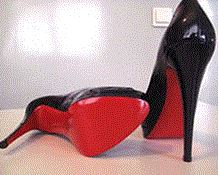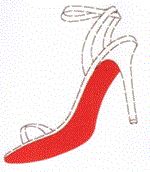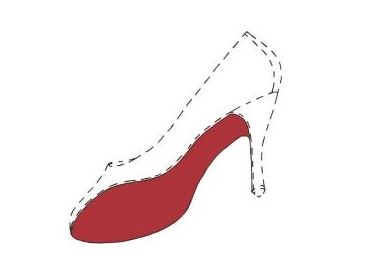
Trademark issue: Red sole(ly) for Louboutin?
The color red means energy, strength, power and passion. Shoe-wise, for most women it means one thing: Louboutins. However, the road was not easy for the French designer. In-and-out of courts for years now, the battles for his in(famous) “Red Sole” linger on. The most complex one, against van Haren, made its way up to the European Court of Justice (CJEU, ECJ) on 27 May 2016. We are giving you a summary of Louboutin´s time in court, as well as keeping you posted on all the updates.

USA
Christian Louboutin had no problem registering his red soles in the USA. Under the registration numbers 3376197 and 3361597, the US Patent and Trademark Office readily protected “lacquered red sole on footwear” or the “Red Sole Mark”.
However, the problem occurred in 2011, when Yves Saint Laurent (or YSL, for short) produced a line of monochrome high-heeled shoes. One of the represented colors was red, and quite similar to Louboutin´s. Louboutin filed a trademark infringement and unfair competition lawsuit and asked the judge to put a stop on the sale of the whole line, not just the red shoes. YSL counterclaimed, asking for cancellation of the Red Sole trademark because it was purely “ornamental” and “functional.” The District Court of New York agreed with YSL, stating that a single-color mark cannot be protected as it is inherently functional. Secondly, it would significantly hinder both the fashion and arts industries. However, the U.S. Court of Appeals for the Second Circuit did not share their opinion. They dismissed the claim that one color cannot pose as a trademark, due to the previous ruling of the Supreme Court of the United States. Then they looked at Louboutin´s advertising campaign and sales´ figures. Finally, upon examining a survey of the public perception of the red sole, they decided this was a case of acquired distinctiveness. However, this implied only a red sole contrasting another color. In other words, if the whole shoe is red, like YSL´s, then it is allowed to use a red sole. In every other case, this color is reserved for Louboutin.
This was a very diplomatic decision by the Court, as it seemed Louboutin was only getting started with the lawsuits in the USA. Right after YSL he sued Carmen Steffens, a Brazilian shoe designer. However, she was able to prove she was using soles in multiple colors (red being just one of them) since 1996.
Rumors have it that Christian Louboutin even went so far to hire a private investigator to find out if his competitor Dior was planning to make red shoes the following season.
In 2013, Louboutin sued, but settled with the designer Charles Jourdan and the retailer DSW, on the basis of their designs and sales of a red-soled shoe.

JAPAN
Non-traditional trademark registration is a novelty in Japan. Hardly imaginable, but, one of the most technology- and invention-driven countries introduced non-traditional trademark protection only after the new Trademark Act in 2014. However, only a couple of days after Christian Louboutin filed an application for his red soles (TMA no: 2015-029921), a similar application was filed by his Japanese competitor. It is yet to be seen what is going to happen, but chances are that Louboutin will not take this infringement lightly.

SWITZERLAND
The problem in Switzerland is that the red sole keeps getting rejected for registration. The first application for a position mark was filed on 25 March 2010, but, the Swiss International Property Office rejected the application. Louboutin unsuccessfully appealed, claiming acquired distinctiveness. The problem was that the Swiss IPO defined the relevant public as men and women of all ages, and acquired distinctiveness was extremely hard to prove among such a broadly defined public.
The case eventually reached the Federal Administrative Court, who gave their decision on 27 April 2016 (decision B-6219/2013). The Court redefined the relevant public, saying it should be limited to younger women. However, they stated that the red color is purely decorative and would not have sufficient impact on relevant customers. There is an abundance of red-soled shoes manufactured and imported, and Louboutin´s are just a part of that market. What is interesting is that acquired distinctiveness was not discussed because Louboutin never claimed it at the Federal Administrative Court. This might not be the end of the Swiss story. Louboutin can appeal, but only on legal grounds.
EUROPEAN UNION
In the EU, Christian Louboutin registered his first trademark in 2000 in France. He filed for EU-wide and international protection immediately, and in 2001, he obtained international protection from WIPO (TM no. 1031242). The procedure with the European Union Intellectual Property Office (EUIPO) did not run as smoothly. Louboutin applied on 29 January 2010, but, on 20 September 2010 the application was rejected by EUIPO´s examiner for the lack of distinctiveness. The Board of Appeal did not agree with Examination Office´s decision and registered the trademark (EUTM no: 008845539) on 16 June 2011.
GERMANY
However, the peace in Europe did not last very long after registration. Following a few inadmissible opposition filings, the first proper threat came when the German shoe retailer Roland SE opposed the trademark. The reason was the possibility of confusion with his trademark “MY SHOES” (EUTM no. 920225). He had a figurative sign registered, with words “MY SHOES” written in white, on a blue and red background. However, the shade of red was very similar on both signs. However, upon examination, the Board of Appeal decided that it is very unlikely the consumer would mistake one brand for another (case R1591/2013-1).

Roland continued with litigation on front of the European General Court (EGC). The verdict was brought in on 16 July 2015 (case T‑631/14). The Court stated that there was no visual similarity between the trademarks, even though the background of “MY SHOES” was predominately red. As the red sole was a position mark and will not be read even approximately similarly to “MY SHOES”, there is no phonetic similarity. As for the conceptual similarity, Roland claimed it is in the connection of the color red and shoes. On one side, we have a red shoe, and on the other hand the word “shoe” on a red backdrop. Also, they both create an image of passion, aggression and heat in consumers´ minds. The Court dismissed these claims as unproven. Also, red was just one of the elements of the previous mark, and there is no concept behind it. All elements considered, the EGC decided there was no similarity that might cause confusion and supported the EUIPO´s decision. This was not where the story ended.
Roland appealed to the ECJ, who gave its final word on 14 April 2016 (case C-515/15 P). The ECJ mostly repeated the wording of previous decisions. The red square in the Roland´s trademark was only decorative and it does not dominate the trademark. There is no visual, phonetic or conceptual similarity. Therefore, the decision of the EGC should be upheld.
FRANCE
In midst of his American lawsuit frenzy, Christian Louboutin also sued Zara Spain in France. The storyline was very similar to the others, Louboutin claimed trademark infringement and unfair competition, while Zara claimed invalidity of his trademark. The Parisian First Instance Court partially ruled in Louboutin´s favor. They stated that although there is no trademark infringement or likelihood of confusion, Zara might have benefited from the red sole on their shoes, and ordered the Spanish company to pay damages.
However, upon appeal, this verdict was overturned (see decision 09/00405). The Court of Appeal decided that there is no trademark infringement due to the fact that there should be no registered trademark, as it lacked in distinctiveness. Neither were the unfair competition claims valid, because no designer can have the monopoly on the concept of putting a red sole on a shoe. Louboutin appealed to the French Supreme Court, which took the stand of the Court of Appeal. They stated that the trademark does lack distinctiveness and should be considered as invalid. However, their reasoning differed from the Court of Appeal´s. The Supreme Court said it was a 3D trademark rather than a 2D one. It could not be registered because the shape is imposed by its function. Where Louboutin made a sloppy mistake was not defining the exact red nuance. Also, the graphical representation of the trademark consisted of multiple shades of red. Therefore, the Supreme Court lined up with the Court of Appeal and Zara ended up as the final winner.
BELGIUM
In Belgium, one of Louboutin´s opponents was Dr. Adams Footwear. The Brussels Court of First instance ruled in favor of Dr. Adams. However, the Court of Appeal did not agree with the previous decision and prohibited Dr. Adams´ further sale of red sole shoes (decision 2014/AR/734 of 18 November 2014.
The second Belgian opponent was Van Dalen Footwear B.V., a Benelux retail store holding a red sole shoe in their repertoire. Louboutin’s claims were predictable, including trademark infringement, unlawful practice and misleading of the customers. Van Dalen’s counterclaims were that the trademark is invalid, because it does not fulfill the prerequisites for a shape mark. The Brussels District Court went along with Van Dalen´s claims (decision 2013/6154 of 20 March 2014). Using the famous Bang & Olufsen loudspeaker case as a reference (case T-508/08) they concurred with the red sole giving substantial value to the shoe. Also, observing the evidence suggested by Van Dalen, showing an abundance of red-soled shoes by different designers and retailers, the Court thought that the shape is common and lacked distinctiveness. With all this in mind, they declared the trademark invalid.
Louboutin instantly appealed and by 18 November 2014 he already had a new verdict in his pocket. Luckily for him, the Brussels Court of Appeal overturned the previous decision (case 2014/AR/843). First they rethought the idea of the sole being a pure shape mark, and disagreed with the First Instance Court. In fact, they abandoned the idea of a shape mark in its entirety, stating that adding another element to a shape does not automatically mean the trademark is still a shape mark. Therefore, the color of the sole cannot be disregarded. However, it does not constitute a color mark, because of the special location and manner in which it is displayed. Bearing all this in mind, the trademark is figurative. Also, it is obvious that the relevant public does know what a red sole means and that the mark is an indication of origin. It is distinctive, albeit the abundance of other red sole shoes. The Appellate Court took a completely different stand from the First Instance Court and imposed a sales’ ban on Van Dalen. This was the first time the judges started wondering what was the limit of the definition of shape, which was elaborated further in the next case, Louboutin v Van Haren.
THE NETHERLANDS

Louboutin sued Van Haren Schoenen B.V., a part of the German Deichmann Group, operating throughout the Netherlands. He based his lawsuit on the Benelux registration of the trademark (TM no. 0874489) in 2009. Van Haren was selling black and blue high-heeled shoes with red soles named and promoted as "5th Avenue by Halle Berry", and Louboutin filed for trademark infringement and deliberate misleading of the customers. He said that the similarity of the shoes would lead the customers into confusion and eventually lead to the dilution of his trademark. Van Haren replied by saying that the red color as a trademark has to comply with the strict rules for registrability of shape marks, set in the Libertel case. The use of the red sole is purely ornamental, which makes the trademark invalid. Therefore, the Hague District Court (case httpLJN:BZ7844) had to first decide whether the “Red Sole” is a color, shape or a position mark. It quickly excluded a color mark, as it cannot be separated from the product. Instead, it said it was a hybrid, a combined color and shape mark. The Court stated that acquired distinctiveness can also be considered, as Louboutin´s red sole is always used the same way and is a major part of the branding of the shoe, and, not just there for decorative purposes. Also, the provided sales´ figures show a large number of sales and enhanced recognizabilty among Benelux population. Comparing the shoes, there are obvious similarities and the fact that Louboutin is an exclusive brand (a.k.a. not sold in mass market stores or for low prices) makes no difference. Louboutin got a preliminary injunction against Van Haren, who had to stop selling their red-soled shoes immediately.
Van Haren appealed to the Appellate Court in Den Haag (case C/09/450182), referring to the decision in Van Dalen vs Louboutin, especially the part that the “Sole” is a shape mark which gives substantial value to the product and lacks distinctiveness. Louboutin argued that the trademark is not purely a shape, but also a color mark. A survey enclosed by Van Haren actually showed a rather large recognizabilty of the “Louboutin sole”. Also, they have shown they were aware of the Louboutin trademark in their adverts. The Court took both facts into consideration and decided that Van Haren was leading the customers into confusion. However, a major twist in the case occurred with the judges being unsure how to correctly interpret, and subsequently apply the Benelux Convention on Intellectual Property (Trademarks and Designs) , whose wording was in line with the EU Trademark Directive (Directive 2008/95/EC). The Directive says:
“Article 3
Grounds for refusal or invalidity
1. The following shall not be registered or, if registered, shall be liable to be declared invalid:
…
(e) signs which consist exclusively of:
(i) the shape which results from the nature of the goods themselves;
(ii) the shape of goods which is necessary to obtain a technical result;
(iii) the shape which gives substantial value to the goods;”
While Van Haren focused on the part that said “substantial value”, Louboutin focused on “exclusively of the shape”, saying color is not a shape. Van Haren replied that they relied on a new version of the Directive from 2015 (Directive (EU) 2015/2436), which says “the shape, or another characteristic, which gives substantial value to the goods”. The vagueness of the wording “or another characteristic” enticed the Court to refer a preliminary question to the CJEU. The Court asked: “Is the notion of ‘shape’ within the meaning of Article 3(1)(e)(iii) of Directive 2008/95/EC to approximate the laws of other Member States relating to Trade Marks limited to the three-dimensional properties of the goods, such as their contours, measurements and volume (expressed three-dimensionally), or does it include other (non three-dimensional) properties, such as their color?”. The question is backed by translational problems of the Directive, as the translation of the word “shape” in some languages includes both signs in both two and three dimensions, and some is limited to 3D.
The ball is now at the ECJ’s court(room), and their answer is highly anticipated.
Related
- "Neuschwanstein" is not a trademark!
- 1 December 2017: Madrid Monitor takes its place as the one and only tool for tracking international trademarks
- 1 January 2020 - Changes in Classifications - Trademarks, Designs, Patents and Utility Models
- 100th Anniversary of Bavaria (Germany) - A glance at trademarks, start-ups, innovation & events
- 10th Anniversary Edition - 10 Things to Know about LexDellmeier - Past, Present & Future
- 14 June 2013: Munich Patent Law Conference - Calculating Damages in Patent Infringement Cases
- 15 Top Brands - Interactive Brand Rating - Years 2000 - 2018
- 15 Years LexDellmeier - 2024 New Year Wishes
- 2014: Statistics for Community Trademarks
- 2024 World IP Day - Building Our Common Future with Innovation and Creativity
